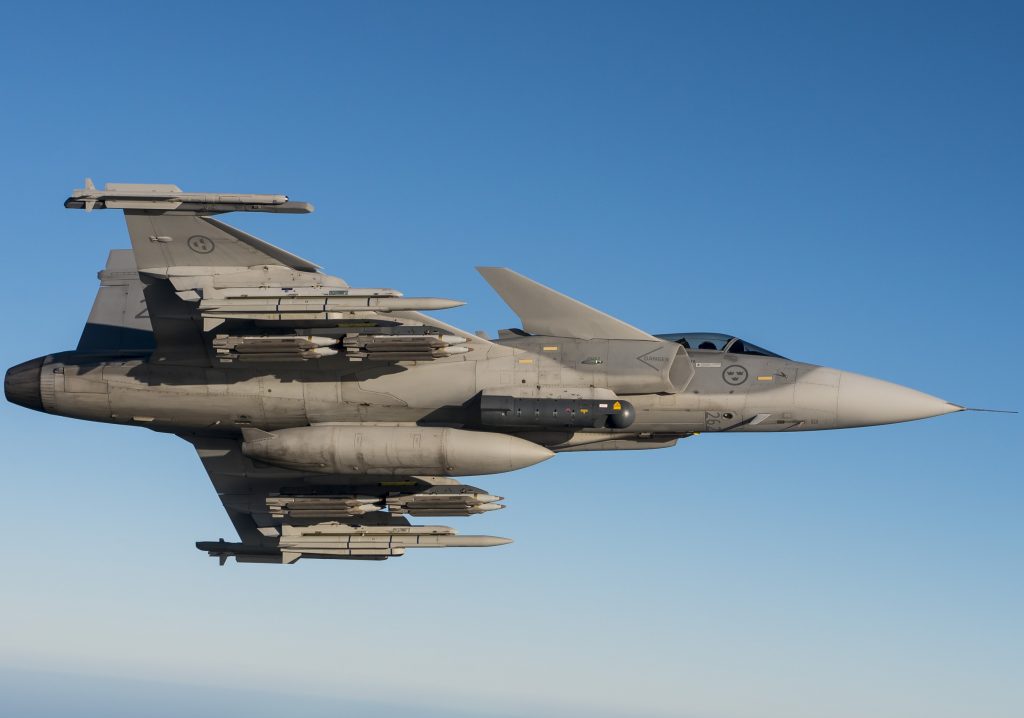Swedish aerospace and defense firm Saab has successfully trialled 3D printing as a means of conducting repairs on its battle-damaged Gripen fighter jets.
In a recent test flight, one of Saab’s supersonic aircraft was fitted with a polymeric additive manufactured replacement hatch, and flown over its Linköping facility without incident. The trial’s success could represent a significant step towards the firm’s use of 3D printed spares for rapid fighter repairs, serving to improve their battle readiness, while reducing the number of parts carried on deployments.
“The potential of this approach means that maintenance personnel in the field can get access to individually-fitted spare parts, and you no longer have to resort to emergency fixes nor cannibalise other broken-down aircraft for their parts,” said Håkan Stake, manager of the development project. “This also reduces the operational time lost in repairs.”
“Post-flight initial inspection of the hatch was very positive and showed no visual structural changes had occurred from the flight.”

A flight test breakthrough
Saab’s groundbreaking test flight on Friday 19th March 2021, marks the first time that any exterior 3D printed part has been flown onboard one of its Gripen fighters. Given that no 3D model previously existed for the part in question, a single outer hatch panel, the firm’s engineers were forced to scan the original and 3D print an exact copy for its replacement.
Built out of the durable PA2200 polymer, the hatch was fitted near the rear fuselage of Saab’s two-seat JAS 39D Gripen fighter, a Mach 1.2-capable jet, and flown over the firm’s dedicated aircraft factory. After the test flight, the tailor-made component appeared to be undamaged, reflecting 3D printing’s potential for producing similar on-demand spares, and expediting the recovery of broken-down planes.
Stake and his team have now moved onto testing alternative materials, with the aim of producing flexible parts that are capable of withstanding cold temperatures at high altitudes. In future, the engineers also intend to develop a container solution, as a means of enabling pilots to take 3D printing gear with them, on deployment to remote locations.
“This test flight of a component with operational impact is an important step as an aircraft, including all its parts, always has to meet the tough requirements of an airworthiness process,” said Ellen Molin, Senior VP and Head of Saab Support and Services. “In terms of increasing operational availability in the field, additive manufacturing will be a game changer.”

Saab’s 3D printing success
While Saab’s recent flight test represents a significant step forward in its adoption of 3D printing, it has already deployed the technology to create multiple internal parts for its aircraft. For over five years now, the firm has worked closely with GKN Aerospace to certify flight-ready components, and develop PBF processes and materials that reduce cost and lead times during aerospace production.
The company was also a founding member of the AMEXCI consortium, a group of leading Swedish industrialists, committed to finding new ways of producing 3D printed parts and equipment. Working alongside the likes of ABB and Scania, Saab has been active within 16 different R&D programs over the last four years, identifying over 300 unique additive manufacturing applications in the process.
“Saab is perhaps the furthest down the line in how it structures its additive manufacturing work,” explained Edvin Resebo, CEO of AMEXCI. “Saab generally makes low to mid-range batches of very complex parts, and in some areas, performance is more significant than the cost per part. We’re only getting started on our journey. There’s so much more to come.”
3D printing becomes flight-ready
Recent 3D printing advances have enabled the production of flight-critical aerospace parts, with the durability needed to survive rapid altitude changes.
Boom Supersonic’s XB-1 aircraft, for instance, features 21 3D printed components produced by PBF 3D printer manufacturer VELO3D. In January 2021, the company opted to release a detailed case study, as a means of providing an insight into the design, manufacturing, and finishing of the Concorde-like supersonic aircraft.
On a slightly smaller scale, Honeywell Aerospace recently managed to gain Federal Aviation Administration (FAA) certification for its first flight-critical engine component. The bearing housing represents a key structural element within the ATF3-6 turbofan engine of the Dassault Falcon 20G maritime patrol aircraft.
Elsewhere, companies like Airbus subsidiary Satair, have adopted metal 3D printing as a means of producing certified aeroplane spare parts for airline clients. By switching from casting to additive manufacturing, the company has been able to create A320ceo wingtip fences more rapidly, flexibly and cheaply than before.
To stay up to date with the latest 3D printing news, don’t forget to subscribe to the 3D Printing Industry newsletter or follow us on Twitter or liking our page on Facebook.
Are you looking for a job in the additive manufacturing industry? Visit 3D Printing Jobs for a selection of roles in the industry.
Featured image shows Saab’s Gripen C/D fighter jet. Photo via Saab.



